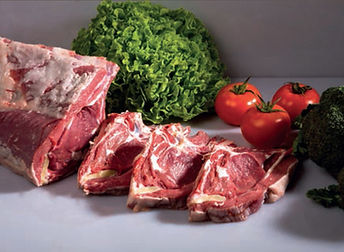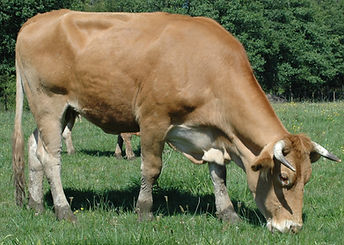“Os Ingleses, que em Portugal haviam descoberto o vinho do Porto, o melhor do Mundo, verificam também o espantoso valor da carne dos bois barrosos. Puseram-se nos portos, com o tilintar das libras a comprá-los. Sobre o Minho correu um caudal de ouro, transformado em cordões e filigranas que compunham o encanto das camponesas” - Prof. Eugénio Castro Caldas (1991)
It was during this period that the "Barrosã" breed reached a strong expansion, boosted by the high value of the castrated and fattened adult cattle, and then, after serving the houses of the little farmers, they were sold on the quay of Porto to be consumed in England under the glorious expression Portuguese Beef - still found today in UK restaurants specializing in meat menus classified as Denomination of Origin Protected (DOP).

BREED
Comes from the region surrounding the mountains of Montemuro, Freita, Arada, and Caramulo.
One of its virtues is the ability to feed on the spontaneous vegetation of the mountains, walking on the steep and rocky rural roads and keeping alive a mountain farming that contributes to its sustainability.
They are medium corpulent animals, with a thick short head, with a sub-concave profile, a thick neck, broad withers, short thick limbs, thick elastic skin which color ranges from straw to cherry, black and hard hooves allowing them an excellent locomotion, dark mucous. They exhibit a docile but energetic behavior.


MEAT
Arouquesa meat PDO shows unique characteristics, presenting variable color between light pink and dark red, depending on the animal´s age.
It has a firm consistency, slightly moist and with a characteristic intramuscular marbling, giving it a unique succulence when cooked.


BREED
It was the Barrosã breed that gave the name to Barroso’s land, which reached its peak in Minho, and it is in this region that today 72% of the total numbers are found.
Of light brown coat, and in some cases tending to straw or cherry color, the Barrosã breed distinguishes itself from others by its considerable armour, as well as its harmonious forms.
The animals of the Barrosã breed graze freely in the traditional wastelands and marshes in perfect conditions of animal welfare, being able to enjoy the natural purity of these places contributing significantly to the preservations of the mountainous landscape, the biodiversity, and sustainability of the rural economy of the region.


MEAT
The Barrosã meat PDO has a very appealing bright red color and, when cut, it looks slightly moist and marbled. The combination of genetic characteristics with an extensive breeding and the exclusive feeding of the calves on the mother’s milk, fodder, acid the muscle infiltration of healthy fatty early intoand cereals, allows fibres, providing the meat with succulent, tenderness and unmistakable flavor, of recognized international merit.
In the National Contests for Traditional Portuguese Meats with qualified names, the meat and hamburgers of Barrosã Meat PDO were awarded “The Best of The Best” medal in 2012, and the Gold medal from 2013 to 2017.


BREED
The Cachena breed, originally from Alto Minho, has the Peneda-Gerês National Park as its site, which includes the extension of the Cantábricos mountains chain with the Peneda, Soajo, Amarela, and Gerês mountains range.
and one of the smallest in the world. It can be found on Cachena is the smallest Portuguese cattle breed and dark hair in the neck area, the color ofbrown-yellowish high mountain, at high quotas (above 800 meters) and for its small size and adaptability to adverse conditions, allows it to define their own sites. It’s able to graze in groups, in wide scattered areas, easily living outside for most of the year.
This is its habitat, its genesis, its territory.


MEAT
A balanced diet based on natural pasture and cereals produced at the farms is one of the conditions for the production of the Cachena da Peneda meat PDO.
This meat is characterized by being a tender, light pink or pale red meat that goes from light to dark. It has little intramuscular fat, a firm consistency, being slightly moist and very juicy.


BREED
Estarreja, it soon spread to from the municipalities of Aveiro, Ílhavo, Vagos, Murtosa. Originally fMarinhoa breed andThe ecological peculiarity of Baixo Vouga, between the Atlantic and the river estuary of Aveiro, determined the origin of a robust animal: the neighbouring municipalities, becoming indispensable in the agricultural work, particularly in the rice cultivation.
Of yellow color, generally tilting to straw, they present a long head, in which the black raised eyes stand out. With short neck, they have a broad and deep trunk. The chest inserts itself into long shoulder blades well-muscled.


MEAT
The meat has a color ranging from pale pink to dark red, depending on the animal’s age. In the veal (up to 8 months), a light pink coloration can be observed; in the calf or “vitelão” (from 8 months to 12 months), the color may vary between pink and light red. It is juicy and tender, with a strong taste and firm texture, with a pleasant consistency to chew.
The scent and the flavor of the Marinhoa meat are not too intense, a characteristic that derives from the environment where they are inserted and the natural food freely grazed.
The Marinhoa’s meat PDO was awarded the Gold medal on the National Competition of Traditional Portuguese Meats with Qualified Names, on the “Vitelão” category.


BREED
The Maronesa breed with its site on the Alvão-Marão mountains, is the closest to the ancestor Auroque, extinct in 1627, one of the immortalized rock engravings of Foz Côa.
The Maronesa breed presents itself as a primitive, natural rustic and mountain breed. It is defined as a local breed since it has remained practically circumscribed to a single region; primitive, since it preserves the main characters of the ancestral type; natural, since the environment is the main influence on its evolution; a mountain breed due to its average height, light skeleton, hard nails, easy movements rustic, natural, primitive Maronesa breed presents itself as a and cunning temperament; rustic for its perfect adaptation to the surroundings.


MEAT
The characteristics of the Maronesa’s PDO meat are, in the veal, the pink color with some evenly distributed fat; in the calf, the red color with moderate intramuscular fat, firm and slightly moist consistency; in the cow, dark red color, strong intramuscular fat, firm and moist consistency.
The succulence is extraordinary and the taste exceptional, providing unique olfactory and taste sensations.


BREED
The traditional production área for the breed is the mid hillside and meadow of the Entre Douro e Minho.
However, there has been an expansion of the breed to the interior and south, being nowadays scattered throughout the Northwest of the country.
It has a thick skin not too elastic and covered with flat, short, thick and more or less harsh hairs, depending on the time of the year and the breeding system itself.
The coat takes on a colour that varies from light red to straw, being the “flavo” (golden) colour the one defined as the breed standard.
In terms of behavior, they assume themselves as animals of docile temperament and easy to handle.


MEAT
It is the only Portuguese autochthonous breed that has triple aptitude: meat, milk, and work, being the meat production the dominating one nowadays.
The breed’s genetic characteristics, together with the extensive production system, the climate, and the region’s soil, grant organoleptic properties to the Minhota meat, emphasizing its pale pink tones, high tenderness, and succulence.


BREED
Miranda do The name of the breed comes from the location of Douro or Terras de Miranda, corresponding to little more than the county of Miranda do Douro.
From there it radiated to the neighboring counties. Therefore, the breed’s sites are the municipalities of Bragança, Macedo de Cavaleiros, Miranda do Douro, Mogadouro, Vimioso e Vinhais.
The rusticity, along with the exceptional traction capacity for the work production and the ability to produce meat in quantity and quality, has led to the dispersion of the breed covering almost the entire national territory. Due to this, the Mirandesa breed became, at the beginning of the twentieth century, the bovine population with greater importance nationally.


MEAT
Mirandesa meat PDO is the highest exponent of the production of the Mirandesa bovine breed which, in harmony with the soil conditions, the climate, combined with the know-how of the people who produce it, resulted in a product of national and international reference. It’s a uniformly distributed fat meat, ranging from light pink to light red.
It stands out for its exceptional tenderness and succulence, distinct scent and flavors.
The “Carne Mirandesa” originated one of the ex-libris dishes of Portuguese gastronomy, mainly the north-eastern Portugal gastronomy, the famous “Posta Mirandesa”.







